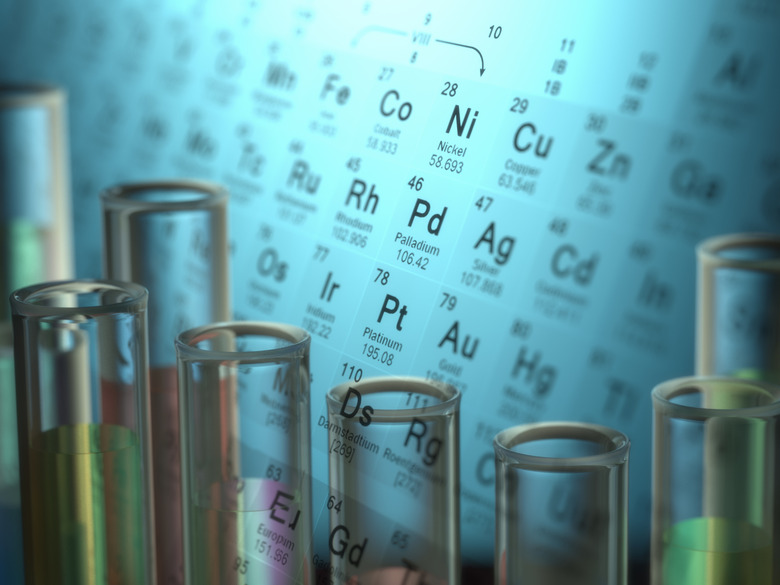How To Find Relative Mass
Relative mass is an important concept in chemistry. It exists to simplify the process of working out the mass of an atom or molecule. In absolute units, protons and neutrons have masses on the order of 10−27 kilograms, which is a billionth of a billionth of a billionth of a kilogram, and electrons have even smaller mass of about 10−30 kilograms, about a thousand times less than a proton or neutron. This would be difficult to deal with in practical situations, so scientists define the relative atomic mass of a carbon atom as 12 and work everything else out on that basis.
TL;DR (Too Long; Didn't Read)
Find the relative mass of any atom by adding the number of protons to the number of neutrons. Hydrogen has a relative atomic mass of 1, and carbon-12 has a relative atomic mass of 12.
Isotopes of the same element have different numbers of neutrons, so you need to calculate for one specific isotope. Periodic tables show the relative atomic mass as the bottom number for an element, but this takes into account any isotopes.
Find relative molecular masses by adding up the contributions from each element. Use the chemical formula to find how many of each atom is included, multiply their relative atomic masses by the number of atoms of each present, and then add them all up to find the result.
What Is the Relative Mass?
What Is the Relative Mass?
Relative mass is the mass of an atom or molecule relative to that of 1/12 of a carbon-12 atom. Under this scheme, a neutral hydrogen atom has a mass of 1. You can think of this as counting each proton or neutron as 1 and ignoring the masses of electrons because they are so small in comparison. So the formula for relative atomic mass is simply:
Relative atomic mass = number of protons + number of neutrons
However, since scientists set a carbon-12 atom as the "standard atom," the technical definition is:
Relative atomic mass = mass of atom ÷ (1/12 of the mass of a carbon-12 atom)
The Relative Atomic Mass of an Element
The Relative Atomic Mass of an Element
Elements are the basic building block atoms created in the big bang or in stars, and they're represented in the periodic table. The relative atomic mass is the lower number on the periodic table (the upper number is the atomic number, which counts the number of protons). You can read this number straight from simplified periodic tables for many elements.
However, technically accurate periodic tables account for the existence of different isotopes, and the relative atomic masses they list are not whole numbers. Isotopes are versions of the same element with different numbers of neutrons.
You can always find the relative mass of an element by adding the number of protons to the number of neutrons for the specific isotope of the element you're considering. For example, a carbon-12 atom has 6 protons and 6 neutrons, and so has a relative atomic mass of 12. Note that when an isotope of an atom is specified, the number after the name of the element is the relative atomic mass. So uranium-238 has a relative mass of 238.
The Periodic Table and Isotopes
The Periodic Table and Isotopes
The relative atomic masses on the periodic table include the contribution from different isotopes by taking a weighted average of the different isotopes' masses based on their abundance. Chlorine, for example, has two isotopes: chlorine-35 and chlorine-37. Three-quarters of the chlorine found in nature is chlorine-35, and the remaining quarter is chlorine-37. The formula used for the relative masses on the periodic table is:
Relative atomic mass = (isotope 1 mass × isotope 1 abundance + isotope 2 mass × isotope 2 abundance + ...) ÷ 100
So for chlorine, this is:
Relative atomic mass = (35 × 75 + 37 × 25) ÷ 100
= (2,625 + 925) ÷ 100 = 35.5
For chlorine, the relative atomic mass on the periodic table shows 35.5 in line with this calculation.
Relative Molecular Mass
Relative Molecular Mass
Simply add the relative masses of the constituent elements to find the relative mass of a molecule. This is easy to do if you know the relative atomic masses of the elements in question. For example, water has the chemical formula H2O, so there are two atoms of hydrogen and one atom of oxygen.
Calculate the relative molecular mass by multiplying the relative atomic mass of each atom by the number of those atoms in the molecule, and then adding the results together. This looks like this:
Relative molecular mass = (number of atoms of element 1 × relative mass of element 1) + (number of atoms of element 2 × relative mass of element 2) + ...
For H2O, element 1 is hydrogen with relative atomic mass of 1, and element 2 is oxygen with a relative atomic mass of 16, so:
Relative molecular mass = (2 × 1) + (1× 16) = 2 + 16 = 18
For H2SO4, element 1 is hydrogen (H), element 2 is sulfur (S with relative mass =32), and element 3 is oxygen (O), so the same calculation gives:
Relative molecular mass of H2SO4 = (number of atoms of H × relative mass of H) + (number of atoms of S × relative mass of S) + (number of atoms of O × relative mass of O)
= (2 × 1) + (1 × 32) + (4 × 16)
= 2 + 32 + 64 = 98
You can use this same approach for any molecule.
Cite This Article
MLA
Johnson, Lee. "How To Find Relative Mass" sciencing.com, https://www.sciencing.com/how-to-find-relative-mass-13710549/. 19 March 2018.
APA
Johnson, Lee. (2018, March 19). How To Find Relative Mass. sciencing.com. Retrieved from https://www.sciencing.com/how-to-find-relative-mass-13710549/
Chicago
Johnson, Lee. How To Find Relative Mass last modified March 24, 2022. https://www.sciencing.com/how-to-find-relative-mass-13710549/
